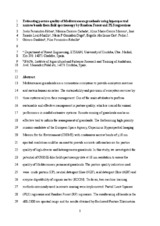Mostrar el registro sencillo del ítem
Estimating pasture quality of Mediterranean grasslands using hyperspectral narrow bands from field spectroscopy by Random Forest and PLS regressions
| dc.contributor.author | Fernández Habas, Jesús | |
| dc.contributor.author | Carriere Cañada, Mónica | |
| dc.contributor.author | García-Moreno, Alma María | |
| dc.contributor.author | Leal-Murillo, José Ramón | |
| dc.contributor.author | González-Dugo, Maria P. | |
| dc.contributor.author | Abellanas Oar, B. | |
| dc.contributor.author | Gómez-Giraldez, Pedro J. | |
| dc.contributor.author | Fernández Rebollo, Pilar | |
| dc.date.accessioned | 2024-02-04T15:14:31Z | |
| dc.date.available | 2024-02-04T15:14:31Z | |
| dc.date.issued | 2022 | |
| dc.identifier.issn | 0168-1699 | |
| dc.identifier.uri | http://hdl.handle.net/10396/27035 | |
| dc.description.abstract | Mediterranean grasslands are a cornerstone ecosystem to provide ecosystem services and sustain human societies. The sustainability and provision of ecosystem services by these systems rely on their management. One of the main attributes to perform sustainable and effective management is pasture quality, which is crucial for animal performance in rainfed extensive systems. Remote sensing of grasslands can be an effective tool to inform the management of grasslands. The forthcoming high-priority mission candidate of the European Space Agency, Copernicus Hyperspectral Imaging Mission for the Environment (CHIME) with continuous narrow bands of ≥10 nm spectral resolution could be an asset to provide accurate information on the pasture quality of high-diverse and heterogeneous grasslands. In this study, we investigated the potential of CHIME-like field spectroscopy data at 10 nm resolution to assess the quality of Mediterranean permanent grasslands. The pasture quality indicators used were: crude protein (CP), neutral detergent fibre (NDF), acid detergent fibre (ADF) and enzyme digestibility of organic matter (EDOM). To do so, two machine learning methods commonly used in remote sensing were implemented: Partial Least Squares (PLS) regression and Random Forest (RF) regression. The results using all bands in the 400-2300 nm spectral range and the results obtained by Backward Feature Elimination (BFE) were also compared. Finally, using importance measures of PLS and RF and the BFE approach, the importance and stability of the bands to assess the pasture quality indicators were explored. The results showed that field spectroscopy CHIME-like data at 10 nm of spectral resolution show potential to predict CP at “good” accuracy and NDF at “moderate” accuracy level in Mediterranean permanent grasslands. PLS outperformed RF to predict CP and NDF in terms of accuracy and certainty of the predictions. The BFE approach increased the accuracy of the predictions, especially in PLS, for which a ∆RMSE= -12.5 was achieved in cross-validation to predict CP. The models built by BFE approach to predict CP using PLS provided a mean R2 value of 0.82 and a range of 0.68-0.90 in bootstrapped predictions. The RMSE was low (mean RMSE=2.23%) and the mean RPD=2.47 with values ranging from 1.81 to 3.23. RF models to predict CP produced mean R2 value of 0.68, mean RMSE=3.00% and mean RPD=1.82. ADF and EDOM were predicted with poor accuracy and similarly by both, PLS and RF. The bands located in the red-edge and NIR region showed high importance and stability to assess the best-predicted variables. Bands centred at 700, 710, 1160, 1170 and 1180 are highly stable and important to predict CP. The bands from the SWIR region had lower stability. This study provides insightful results on the use of hyperspectral data and future satellite missions such as CHIME to assess the pasture quality of Mediterranean grasslands that can be crucial to inform the management and monitoring of Mediterranean permanent grasslands. | es_ES |
| dc.format.mimetype | application/pdf | es_ES |
| dc.language.iso | eng | es_ES |
| dc.publisher | Elsevier | es_ES |
| dc.rights | https://creativecommons.org/licenses/by-nc-nd/4.0/ | es_ES |
| dc.source | Fernández‐Habas, J., Carriere Cañada, M., García-Moreno, A. M., Leal‐Murillo, J. R., González‐Dugo, M. P., Abellanas Oar, B., Gómez-Giráldez, P. J., & Fernández‐Rebollo, P. (2022). Estimating pasture quality of Mediterranean grasslands using hyperspectral narrow bands from field spectroscopy by random forest and PLS regressions. Computers and Electronics in Agriculture, 192, 106614. https://doi.org/10.1016/j.compag.2021.106614 | es_ES |
| dc.subject | Crude protein | es_ES |
| dc.subject | Band selection | es_ES |
| dc.subject | Backward feature elimination | es_ES |
| dc.subject | CHIME | es_ES |
| dc.subject | Band importance | es_ES |
| dc.subject | Heterogeneity | es_ES |
| dc.title | Estimating pasture quality of Mediterranean grasslands using hyperspectral narrow bands from field spectroscopy by Random Forest and PLS regressions | es_ES |
| dc.type | info:eu-repo/semantics/article | es_ES |
| dc.relation.publisherversion | https://doi.org/10.1016/j.compag.2021.106614 | es_ES |
| dc.relation.projectID | Gobierno de España. PID2019-107693RR-C22 | es_ES |
| dc.relation.projectID | Gobierno de España. FPU18/02876 | es_ES |
| dc.relation.projectID | Junta de Andalucía. GOP2I-HU-16-0018 | es_ES |
| dc.relation.projectID | info:eu-repo/grantAgreement/EC/H2020/774124 (SUPER-G) | es_ES |
| dc.rights.accessRights | info:eu-repo/semantics/openAccess | es_ES |

